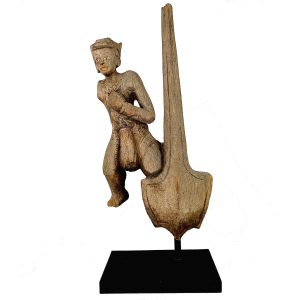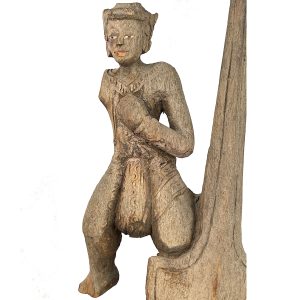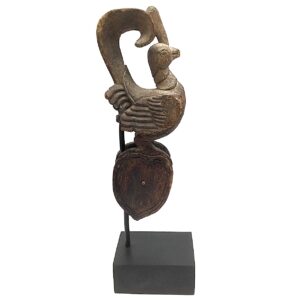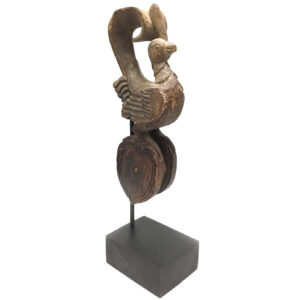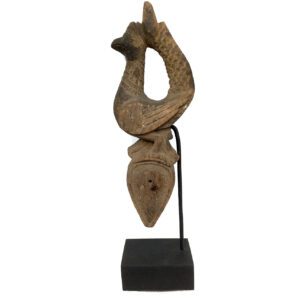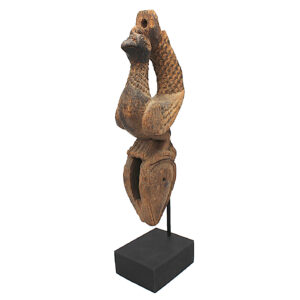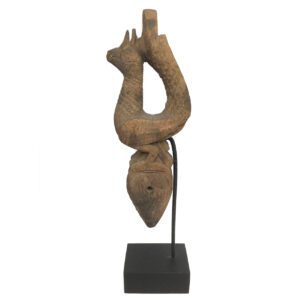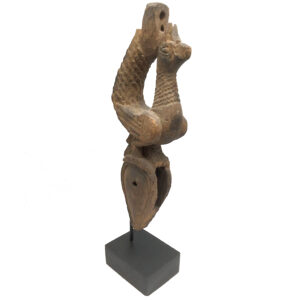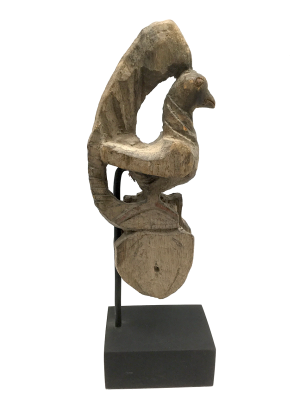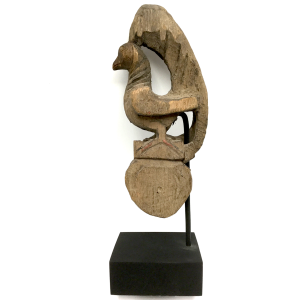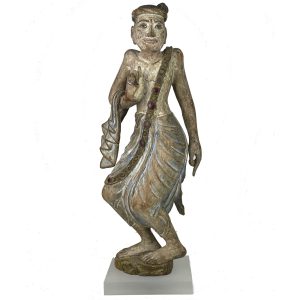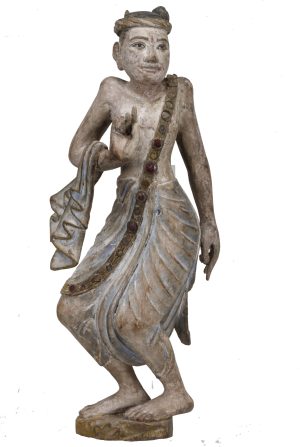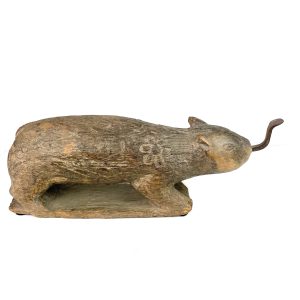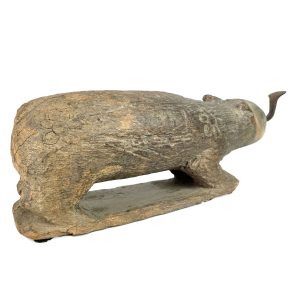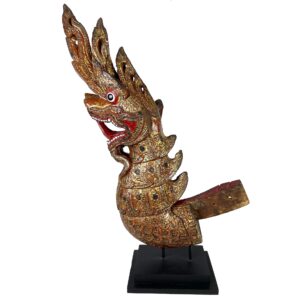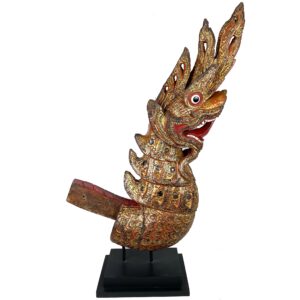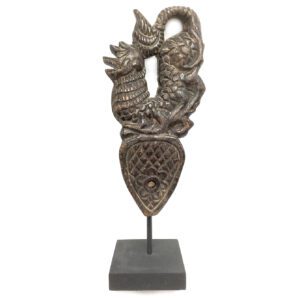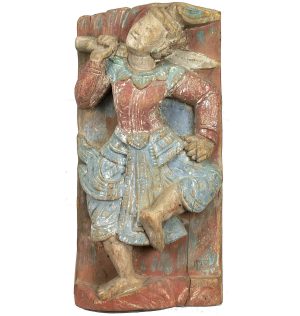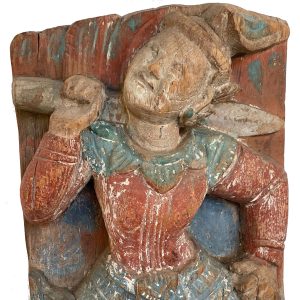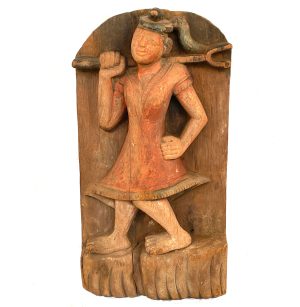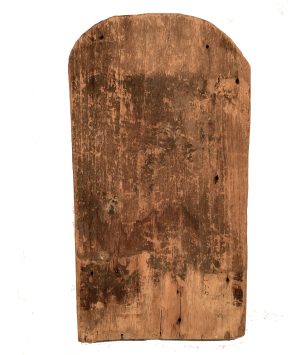-
Sale!


$450.00 Original price was: $450.00.$315.00Current price is: $315.00.
H: 23″ W: 10″ D: 5.5″ | CALL 213-568-3030 OR EMAIL [email protected] FOR SHIPPING
This fanciful teak carving is a Nat placed atop a large shield wearing a sarong and eyes with inset mother of pearl. Although of shamanistic origins, they are still in Buddhist temples, pagodas, government buildings, and in nat centers throughout Burma.
-
Sale!


$235.00 Original price was: $235.00.$165.00Current price is: $165.00.
H: 10.5” W: 3.25” D: 2.375” | FREE SHIPPING WITHIN CONTINENTAL U.S.
Elegant antique heddle-pulley carved from a single piece of Burmese teak topped by a hamsa, a goose-like bird and sacred Buddhist symbol of wisdom. Auspicious symbolic animal images are believed protect the weaver, assure quality weaving, and pleases the gods and spirits. Finely weathered from time and use.
-
Sale!


$245.00 Original price was: $245.00.$185.00Current price is: $185.00.
H: 13” W: 3.75” D: 2.625” | FREE SHIPPING WITHIN CONTINENTAL U.S.
Burmese teak heddle pulley surmounted by a graceful peacock that symbolizes wholeness, combining colors and fleeting nature of all things. Based on old animistic beliefs, heddles are decorated with auspicious animals providing the weaver protection, assuring good quality weaving and pleasing the gods.
-
Sale!


$245.00 Original price was: $245.00.$175.00Current price is: $175.00.
H: 14″ W: 2.675” D: 3.5” | FREE SHIPPING WITHIN CONTINENTAL U.S.
This elegant heddle pulley carved from a single piece of Burmese teak is topped by a peacock, which in Buddhism represents the short-lived nature of all things. In Burmese animistic traditions, it auspicious animal images protect the weaver, assure quality weaving, and please the gods and spirits. Finely weathered from time and use.
-
Sale!


$265.00 Original price was: $265.00.$185.00Current price is: $185.00.
Ht: 10.625″ W: 3.375″ D: 2.5″|FREE SHIPPING WITHIN CONTINENTAL U.S. !
This elegant antique heddle-pulley carved from a single piece of Burmese teak is topped by a hamsa, a goose-like bird and a sacred Buddhist symbol of wisdom. Auspicious symbolic animal images are believed protect the weaver, assure quality weaving, and pleases the gods and spirits. It is wonderfully weathered from time and use with minor losses with a fine patina. Mounted on a black wood base, this heddle pulley pairs well with item number 11298A.
-
Sale!


$1,350.00 Original price was: $1,350.00.$950.00Current price is: $950.00.
H: 19.75″ W: 7.75″ D: 5″ | FOR SHIPPING QUOTATION CALL US AT 213-568-3030 OR EMAIL [email protected]
This exquisite teak carving of a Mandalay Burmese male dancer wearing a sarong is in a fluid twisted pose emphasizing his strength, balance and grace with his raised hand is in a position similar to a Buddhist mudra. His humble status is reflected his head scarf and a bejeweled sarong with insert glass that reflect light and add movement and depth. His joyful beautiful face stares with open eyes and slightly parted lips It is simply a gorgeous work mounted on a contemporary frosted stand to complement any setting.
-


$395.00
SOLD
This antique coconut grater is a very practical multi-use creation designed to cut, grate, shave, husk, and shred coconuts and large fruits and vegetables. Some were carved as crouching rabbits and others like this were realistic renderings of small mammals. Its decorative appeal includes lovely 6-petal flowers above its four legs and elegantly curved and metal piece extending ” W:from its mouth. With its warm and rustic feel, it would be a unique decorative addition to any kitchen and an interesting conversational piece.
-


$1,133.00
H: 32″ W: 20″ D: 7.5″ SHIPPING INFORMATION REQUIRED. CONTACT US AT 213-568-3030
This exceptional naga was one of two that comprised a gong stand. Gongs were used in Burma for both ceremonial and musical purposes in religious, state, or secular settings. A protection figure, this naga is a superb carving elaborately decorated with gold lacquer and pigmentation. He opens his mouth wide bearing mother-of-pearl teeth and a curled blood red mouth and tongue to drive away malevolent spirits, also reinforced by the large glaring eyes circled in red. On first glance it is menacing, but its history as a protector of Buddha Shakyamuni make it prized as a fanciful, gleeful guardian. His scales are arched relief designs of mixed lacquer and ash and they are highlighted with inset cut mirrors and green sequin-like glass “jewels.” It is mounted on a museum quality stand and is in excellent condition for its age and use despite missing an ear.
-
Sale!


$245.00 Original price was: $245.00.$175.00Current price is: $175.00.
Ht: 12” W: 4.125” D: 3.25” | FREE SHIPPING WITHIN CONTINENTAL U.S.
Vintage Burmese teak heddle-pulley used in strip-weaving on small handlooms. Here surmounted by a ferocious mythical lion as guardian of Buddhist law. Mythical beasts believed to protect the weaver and assure high quality weaving.
-


$335.00
Traditional Burmese dance has its roots in folk religion and is a combination of ancient animism, nat worship and a later syncretic blend with Buddhism. Ethnic minorities often perform dances that include warriors , Zawgyi (shaman) and nats wielding swords or holding drums while dressed in full-body costumes. Burmese performances were regulated with limitations on…
-


$335.00
Burmese women always did strenuous work, yet they rarely see themselves as farmers. This is due to Burma’s old patriarchal culture, Burmese laws and narrow rural beliefs defining them as workers laboring for men only: their father, brother or husband. This wonderful painted wood panel of a barefoot female farmer depicts her with the long…
End of content
End of content

